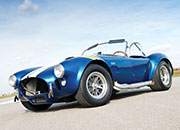

The car experts at Hagerty® have put together the following classic car start-up checklist. If your car has been sitting for a while, take the time to prep before a long drive. You’ll both be better for it.
Start with your battery. If it’s been on a trickle charger all winter, disconnect it from the charger and reconnect the battery. If you simply removed the battery and stored it in a warmer spot for the winter, time to charge it up.
Check your fluids. Start with a walk around and examine the floor beneath the car. Drips are common and expected; puddles are not. A fresh oil change is recommended since water or other fluids may have found their way in your crankcase. While you’re at it, replace the oil filter. Also check your other fluids – brakes, coolant, transmission, windshield washer. Do they look dirty? Are they at the recommended level? Smell your transmission fluid. If it smells burnt, change it.
Generally speaking, if you can’t remember the last time you drained and flushed any particular fluid, it’s probably time to do it again. As for gasoline, your car should be good to go if you put STA-BIL in the gas tank before storing your car. If not, you might consider adding a water-absorbing product or – if you’re really worried about it – drain the tank.
Check your belts and hoses for cracks and decay. Since rubber breaks down over time, examine the condition of your tires. Make sure they’re inflated to the correct air pressure, and remember the spare.
In addition to potentially damaging your engine, water can cause brake problems as well. If your car has been sitting for a while, consider bleeding your brakes. They should feel firm when you push the pedal.
By this point, you should already know if any mice spent a comfortable winter in or around your engine.
Also check inside the passenger compartment, especially under the seats and in the glove box.
And one last thing – check the headlights, turn signals and brake lights. Yes, this requires a friend’s help.
If you’re just testing the engine, make sure an exit door is open enough to allow exhaust fumes to escape. If the weather allows for a drive, make that first one fairly short – a half hour or so should put the car through its proper paces. And before you take drive No. 2, do the ol’ walk-around again. No major leaks? Tires look good?
Let ‘er rip, and enjoy the drive.
